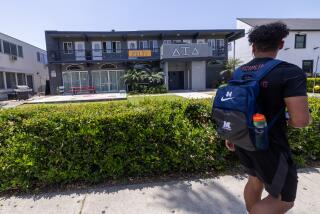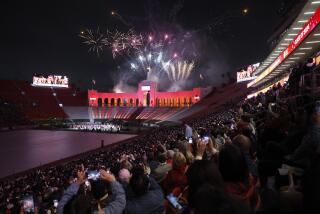Slain USC student was a gun control advocate who believed music could âheal the worldâ
When Alinzia Davenport recalls her godbrother as a little boy, a vivid image comes to mind: a tiny Victor McElhaney in the middle of a drum circle led by older men, keeping up with the beat on his bongos.
âI just knew one day he was going to be a famous old man and weâd be going to his concerts,â Davenport said.
McElhaney devoted most of his life to the intersection of community and music. The 21-year-old son of Oakland Councilwoman Lynette Gibson McElhaney began playing drums before he could read. By the time he moved to Los Angeles in the fall of 2017 to study jazz at the University of Southern California, he had made his mark on Oakland as a mentor to other young performers and an advocate for black lives, women and gun control.
For his friends and family, then, there is devastating irony in the way McElhaney died.
USC stunned after music student, son of Oakland councilwoman, fatally shot near campus Âť
At around 12:30 a.m. Sunday, McElhaney and eight friends walked from a nearby home to a strip-mall liquor store at Maple Avenue and Adams Boulevard, about a mile and a half from USC, said Los Angeles Police Capt. Billy Hayes, who oversees the Robbery Homicide Division. After buying booze, the group was approached in the parking lot by three or four men. The men attempted to mug the group, and McElhaney was shot likely after objecting to the robbery, Hayes said. The suspects fled in a car. No one else was hurt.
McElhaney was taken to the hospital in critical condition and pronounced dead at 11 a.m. Sunday. No arrests had been made in connection with the shooting as of Monday afternoon.
Those close to McElhaney described him as a critical thinker who thrived off making people smile, and a goofy and animated humanitarian. He was known for his big hugs and an intense love of percussion.
More than anything, he believed in the power of music to bring people together.
âHe thought it could heal the world,â Davenport said.
McElhaney was 11 years old when he started studying at the Oakland Public Conservatory of Music. Even at that young age, he displayed a deep passion for West African drumming, said Angela Wellman, the conservatoryâs founding director.
He was soon a fixture at the conservatory, studying music after school, attending its summer academy and playing timbales on stage at Oaklandâs Art and Soul Music festival as part of the Frederick Douglass Youth Ensemble. He absorbed wisdom from the elders in Oaklandâs African American community and became a teen mentor to younger kids at the conservatory, Wellman said.
McElhaney had a deep understanding of the historical significance of being an African American who played jazz, Wellman said, and âthe importance and the depth of the rhythmic impulse of the music and where that comes from.â
âHe represented the promise we hold for all our youth, particularly for our black youth,â she said.
Wellman advised a teenage McElhaney to head to the East Coast for college, but he wanted to stay close to home. He attended Cal State East Bay before transferring to USC, where he was an active member of the Center for Black Cultural and Student Affairs.
McElhaney made an impression on his classmates at USCâs Thornton School of Music. Athena Sferas, a 19-year-old sophomore, took a course with McElhaney in the fall that delved into how music and art have influenced history.
It was one of those large, introductory discussion classes where most people were hesitant to contribute, Sferas said. But McElhaney wasnât afraid to politely challenge students whose views he didnât agree with.
âAs a black student, he felt there were voices throughout history that havenât been heard,â Sferas said. âHe wanted to make sure black narratives werenât left out.â
McElhaneyâs death comes just a few years after his family lost another loved one, 17-year-old Torian Hughes, to gun violence. Torian, whom McElhaneyâs parents helped to raise, was shot and killed during a robbery in West Oakland in 2015.
The death broke McElhaneyâs heart, said Azariah Cole-Shephard, a 20-year-old Oakland poet who knew McElhaney since preschool. After the tragedy, she said, McElhaney would often initiate conversations about gun violence in person and on social media. He was his momâs biggest cheerleader as she helped create the cityâs Department of Violence Prevention and led an effort to preserve Measure Z, a public safety measure that funds investment in community policing and violent crime prevention strategies.
âI know that if this wasnât him and it was someone else, he would have his arms around each and every one of his family members, letting them know that it would be OK,â Davenport said of the shooting. âHe would want his community to rally together against gun violence.â
At McElhaneyâs farewell party just before he left for USC, the guest of honor asked Cole-Shephard to perform her poem âFor the Black Men My Love Cannot Protect.â She recited lines that mourned the lives of young black men cut short by gunfire.
âWe turned around and lost him to the same thing,â Cole-Shephard said. âIt just goes to show that no matter how much you love somebody, you canât protect them from the bullet that comes their way when youâre not physically present.â
In a statement Sunday night, Councilwoman McElhaney â whose council district covers West Oakland, the cityâs busy port and the area north of downtown â said her sonâs death represents the âbeginning of a new chapter in this reoccurring circle of violence.â
âI miss my baby,â she wrote. âPlease keep me, my family, and all of my sonâs friends in your thoughts and prayers.â
While crime has steadily trended downward during the last 15 years in the area around USC known as University Park and in its eastern neighbor the Old Historic South Central, they remain among the cityâs most dangerous neighborhoods.
University Park ranks 35th for violent crime and 7th for property crime out of 209 areas of the city, according to a Times analysis. The Historic South Central area, which includes the strip mall at Adams and Maple, ranks 22nd for violent crime and 49th for property crime. Analysis of homicides in the two combined areas since 2000 shows a downward trend. From 2000 to 2009, the average number of homicides each year was 12. The average dropped to roughly eight between 2010 and this year.
Several high-profile incidents in recent years have sparked debate about the best ways to keep USC students safe.
On Friday, 22-year-old Alberto Ochoa was sentenced to life in prison in connection with the 2014 beating death of a USC graduate student. Xinran Ji, 24, was walking home from a study group near the campus when Ochoa and three others robbed and attacked him with a bat.
Jiâs death followed the killing of two graduate students in 2012 during a botched robbery near campus. Six months later, a man fired gunshots in the middle of campus outside a Halloween party and four people were injured. None were USC students.
LAPD Capt. Lee Sands noted that McElhaney was shot outside the area patrolled by the division that handles USC Southwest, and beyond USC Department of Public Safety boundaries.
USC has built a network of security cameras, license plates readers on poles and mobile sentry posts that extend into the neighborhoods beyond the campus. It was a license plate reader on a pole that helped LAPD homicide detectives investigate the case of two Chinese students killed in 2012.
Cole-Shephard said it is hard to imagine McElhaney losing his life during a robbery. If someone had asked McElhaney to give up what he had, she said, he would do it without hesitation.
âHe never valued stuff more than he valued life,â she said.
More to Read
Sign up for Essential California
The most important California stories and recommendations in your inbox every morning.
You may occasionally receive promotional content from the Los Angeles Times.














